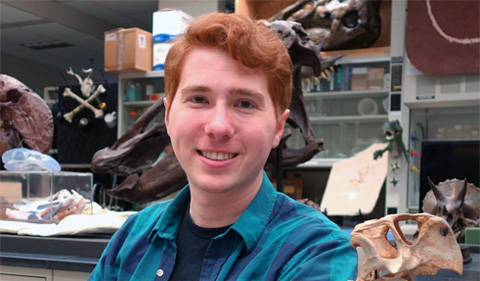Biological Sciences graduate student James Nassif is presenting preliminary data regarding the morphology and physiology of the middle-ear conduction apparatus in both extinct and extant reptiles at the Association for Research in Otolaryngology’s Midwinter Meeting in San Diego from Feb. 9-14.
The ARO meeting features cutting-edge basic and clinical research in the field of otolaryngology.
Abstract: The middle ear is thought to have evolved to decrease the loss of energy as sound waves pass from the environment to the inner ear. Though absolute frequency sensitivity is not strongly correlated with middle ear function, critical functions including sound localization and inner-ear damage mitigation have been tied to middle-ear morphology across diverse species. Whereas mammals are often the focus of middle-ear anatomical research, the evolution and dynamics of the independently-evolved hearing systems of other vertebrates have received less attention. In living reptiles and birds, the middle-ear conduction pathway is comprised of a single rod-like ossicle (the columella), typically connected to a tympanic membrane by cartilage. Birds and non-avian dinosaurs present an opportunity to explore both the physical and developmental constraints of the ear across many different magnitudes of size. Because the hearing apparatus of extinct reptiles is poorly understood, basic anatomical investigation is necessary to explore any functional consequences of morphology. Though the columella is the only middle-ear structure known to fossilize, preliminary investigation suggests that the anatomy of the middle ear in extinct species may be constrained through identifying osteological correlates in extant taxa of both key soft-tissue structures and unpreserved hard tissues. Cadaveric specimens representing ecologically and taxonomically diverse birds and several species of crocodilian were µCT scanned, and ear structures including columellae were digitally reconstructed using Avizo. Specimens were also dissected to visualize the anatomy and identify the attachments of middle-ear structures to hard tissues. Fossil specimens were also scanned and photographed. Using data from dissections and scanned specimens, tentative osteological correlates of soft tissue structures were identified and compared to the osteology of extinct taxa, consistent with established methods of phylogenetic bracketing. Additionally, the shape and size of incompletely preserved columellae were constrained by the anatomy of the braincase. Though the columellae of some ornithischian dinosaurs are dimensionally similar to those of extant reptiles, the columellae of large theropods such as Tyrannosaurus are exceptionally long and thin. Other groups show morphologies that may be consistent with atympanic middle ears. Preliminary mechanical analyses suggest these extreme morphologies have functional consequences for the transmission of sound. These results are compared to previous studies of archosaurian ear morphology. Beyond evolutionary implications, any insights into the functional morphology of a single-ossicle middle ear have potential applications in the design of prosthetic implants for humans that are better able to meet the challenges of an active life.




















Comments